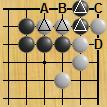I was looking ahead a bit in my reading of The Second Book of Go (Beginner and Elementary Go Books) and came across the following (I changed it slightly from the book by adding an extra letter, but otherwise is the same save this one is in color rather than 2d black and white):

Here we see the marked white stones has liberties at A and B and the marked Black stones have liberties and B and C. Generally when counting liberties that is where I would have stopped. However Black in this case has one more liberty.
White can play neither B nor C, else she puts itself in atari. That is, if she played B, Black would capture that stone and the marked stones by playing A. If she played C, Black would capture that stone and one more by playing D. So White must first play C, meaning even if White plays first she’ll loose as it would take one more move on her part. (Generally in a capture race, with everyone having the same number of liberties, the one who goes first will win.)
